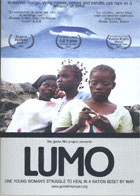
Lumo 2007
Distributed by Cinema Guild, 115 West 30th Street, Suite 800, New York, NY 10001; 212-685-6242
Produced by Bent-Jorgen Perlmutt and Nelson Walker III
Directed by Bent-Jorgen Perlmutt and Nelson Walker III
DVD, color, 72 min.
Sr. High - Adult
African Studies, History, Health Sciences, Women's Studies
Date Entered: 07/15/2009
Reviewed by Charles Burkart, Media Bibliographer, West Virginia University, Morgantown, WVVirtually unknown to most Americans, the Democratic Republic of Congo has been the scene of a decade long civil war. This vicious continent wide conflict claims the lives of over 1,000 people per day. In this unconventional war, rape is used systematically by the combatants to subdue and intimidate the civilian population. Many of the unfortunate women gang raped by the militias develop fistula—a medical condition where the wall between the bladder and vagina are destroyed. Fistula leads to both incontinence and sterility.
Lumo Sinai, afflicted with fistula, is a twenty year old rape victim from the Masisi region of Eastern Congo. Her treatment and convalescence is the subject of Lumo, a documentary recently shown on PBS’ POV (Point of View). Rejected by both her family and finance, Lumo is transported to the HEAL Africa Hospital at Goma for treatment. At the hospital, she undergoes five separate operations over a two year period to cure her fistula. During her time at the hospital, Lumo is cared for by sympathetic women counselors/health workers called “Mamas” by the hospital patients. Lumo and the other hospital patients have little to do but gossip and socialize between operations. Most of the female patients are confined to bed for long convalescent periods.
Lumo is filmed in the cinéma vérité style of documentary movie making. Cinéma vérité uses staged setups, long medium shots, and close-ups to enhance the realism of the subject matter. In many cases, we are unconscious that the camera, which acts as an invisible narrator, is even filming. The sound in Lumo is clear and well modulated. The picture is bright and the colors vivid. Subtitles are easy to read and unobtrusive. Editing is professional and interesting.
As far as criticisms for Lumo, I would have appreciated more information on the grossly under reported Civil War in the Congo. Furthermore, it could have been edited to a more academically convenient thirty minute format from its current seventy two minute length. Nevertheless, Lumo has won a number of awards for 2007, including a “Student Academy Award”, “President’s Award, Full Frame Documentary Film Festival”, and was an “Official Selection” for the Human Rights Watch Documentary Film Festival.
Lumo is important in publicizing the tragic condition of these suffering women and the valiant international efforts (like HEAL Africa) to help them. Lumo would be useful in college African studies and African history programs. In addition, it has cross-over value in women’s studies and health-related medical programs. I can recommend this timely and important new documentary.